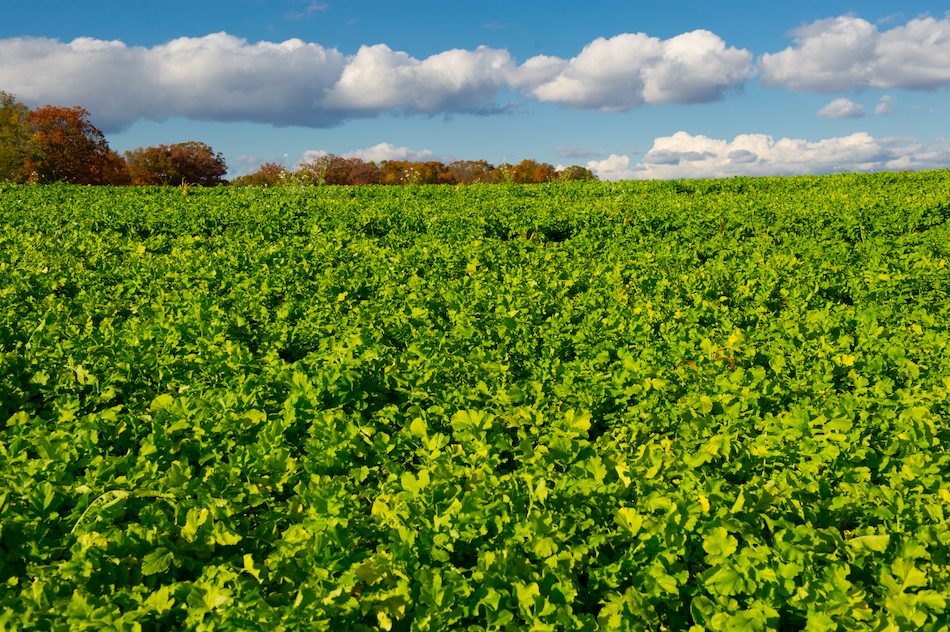When Yvonne Lawley wrote her research proposal for a study of cover crops, she was specific about the wording of the title: Testing the cover crop hypothesis across Prairie Canada.
It’s the word “hypothesis” that grabs you. What could be theoretical about cover crops? Some farmers have been using them for decades to help build soil, reduce erosion, graze animals and more. The practice is common in Ontario and Quebec, as well as in the Northern Great Plains region of the U.S. What’s not to know?
Well, when it comes to the Canadian Prairies, quite a bit, says Lawley, an assistant professor in the department of plant science at the University of Manitoba. “Our prairie environment is much more variable and more prone to extremes compared to other areas where cover crops are regularly used.”
Lawley says the thinking behind cover crops on the Prairies has shifted since the time they were considered only for green fallow. “The reasons why we might want to add cover crops are very diverse — soil health, reducing erosion, extending grazing, reducing inputs — so there is now a very diverse range of goals.”
“And that’s why I put the word ‘hypothesis’ in there — because farmers are hearing about cover crops everywhere, but here in this environment, we don’t have a lot of data to show how they actually work.” So with funding from Western Grains Research Foundation, Lawley is leading a team of scientists and graduate students for a new five-year project that aims to find some answers.
The experiment
To generate this data, Lawley has set up a large-plot crop rotation experiment at four sites across the Prairies (Carman, Man.; Lethbridge, Alta.; Saskatoon and Redvers in Saskatchewan) representing a range of soil types and moisture conditions.
There are two main treatments at each site — a four-year annual crop rotation that includes cover crops and the same rotation without cover crops. Third and fourth treatments will act as checks and reflect typical farming practice — a two-year short wheat-canola rotation and a four-year planting of alfalfa or alfalfa-grass mix).
For the first two treatments, cash and cover crops were chosen to reflect regional practices, with wheat and canola at every site, plus a second cereal crop and a legume suited to each location (soybeans in Manitoba and pea in Alberta and Saskatchewan, for example). Cover crops include legumes (like clover), brassicas (such as radish) and grasses (fall rye, for example). All sites will use direct seeding and minimum till, although the Saskatoon site includes one high-disturbance crop (potatoes) for comparison.
“In some ways it’s very simple — we’re comparing two rotations, one with and one without cover crops,” Lawley says. What’s not so simple is that the rotations are fully phased at each site. This means that all crops will be present in all years of the study, thereby removing weather as a factor in the results.
Lawley and her team believe this work will help to definitively show if cover crops can be reliably grown on the Prairies in the first place and if so, their effect on subsequent crops in terms of yield, nutrient availability, input costs, pest control and soil health. “We’re going to be doing an economic analysis and look at the impact on crop production and the soil,” she says. “What’s the benefit of that living root? We’re going to try to put some numbers to that.”
The experiment also offers a golden opportunity to study the effect of cover crops on nitrogen cycling. Nitrogen needs to be available in the soil when the crops need to use it, and researchers want to know if cover crops help or hinder that process.
The study will also look at the effect of cover crops on greenhouse gas emissions. “We want to know if storing nitrogen in cover crop biomass — living or dead — impacts nitrogen loss in the early spring, which is when most N2O emissions are generated,” Lawley says.
Watch this space
“In some ways, we already know we can do this,” Lawley says, explaining that early adopters of cover crops have shown it can work on their farms. “But others are still wondering if it’s worth their time to grow cover crops, so we’re doing this work for them, and also to produce information for agronomists, who get asked questions about cover crops all the time, and need local research to refer to.”
The team has just wrapped up its second field season, so it’s an exciting time for the data crunchers. “In the first year we got baseline samples,” says Lawley. “We’re at the point now where grad students are coming on board to do the intensive sampling and getting all our measurements.”
And farmers don’t have to wait until 2022 to find out what Lawley and her team are learning along the way — check out #PrairieCoverCrops. “Social media is a real enabler of cover crops and soil health information for farmers,” Lawley says. “It’s key for knowledge transfer and for researchers to know what questions farmers are asking. People with good ideas could be so isolated before social media — it’s been a game-changer.”





Post a comment
Report Abusive Comment